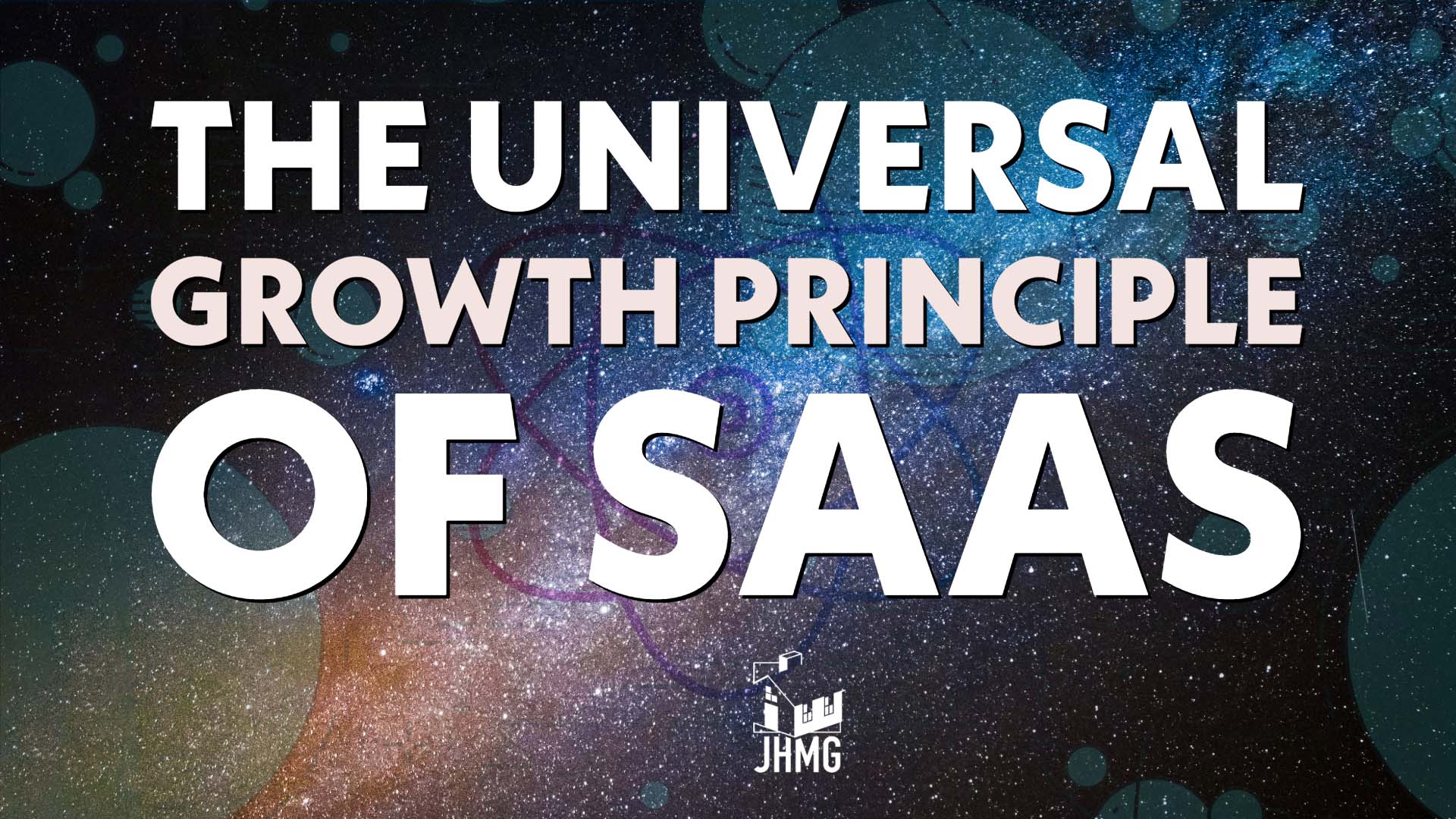🎁 Before diving into SaaS sales teams, demand generation, product development, and everything in between, the first and most crucial aspect must be in place.
If your customers NEED the solution, have the ABILITY TO PURCHASE, and you can stand in the STREAM OF DEMAND, then SaaS growth is easy.
The corollary is that if you can’t find a need and the ability to purchase, then even with the most demand and the greatest solution in the world, there will be no sales in your future.
Whether you are launching a new product to an existing market of millions of customers or launching a startup with no pre-built market, determining need and ability to purchase are the first steps in ensuring success of the SaaS growth strategy. After you’ve determined those items, then we can start talking about building products that solve problems and standing in the stream of demand, which will be covered in upcoming newsletters.
⚙️ Crafting Solutions for Real Problems With SaaS Solutions
So often, companies create a SaaS solution and then look for a problem to solve with their solution.

I talk a lot about a thorough and complete SaaS validation process. There have been successful businesses that started with a solution and found the problem, but by far that is the exception, not the rule. This is particularly true in SaaS because a business will often build an in-house system to solve their problems, then work to distribute the system without investigating if everyone else uses the same processes as they do.
Once they’ve spent large amounts of money building the product, they realize that other teams use dramatically different processes and the only way the current system could be distributed is if they teach the other companies how to use their system. This process has worked many times, but when it’s successful, it almost always starts with a process and an education process, then leads to an application. The software supports the existing process and educational systems and existing client base, then enables scalability.
But without those things in process first, your SaaS growth is impossible.
💥 Existential Triad of SaaS: Time, Knowledge, and Compliance
For SaaS businesses, the problem always comes in the form of either a time and thus cost savings, a knowledge gap, an imposed requirement like a government compliance requirement, or any combination of these three. In other words, an increase in efficiency or a requirement. Many times, SaaS systems cover both the time/cost gap and the knowledge gap.
⏲️ Time/Cost Gap
A great example of a time-saving SaaS is Google Docs. I am writing this document now on Google Docs. While word processors are a commodity these days, Google Docs is used worldwide because it allows businesses to work locally or on the web, share easily, have documents be a part of a larger ecosystem, and much, much more. The time savings of this seemingly commoditized system are so great that millions, possibly billions of people use it worldwide. In fact, as I look around at the coworking space I’m at today, of the 10 people’s computer screens I can see, three of them are currently using Google Docs.
📖 The Knowledge Gap
A great example of a knowledge gap SaaS example is LexusNexis. This started as a system to look up case law for attorneys. It has grown into a substantially more robust tool that now incorporates AI and helps attorneys do everything from answering legal questions to accelerating the litigation process. The start of this system though was to “resolve legal research issues quickly and confidently.”
🏛️ The Imposed Requirement
A great example of an imposed requirement is in healthcare. In many states, the government requires certain types of healthcare facilities, in this case post-acute care (nursing homes), to have an electronic health records (EHR) solution in place or be fined. Initially, there will be a fine in some states, but in the long term it will not be possible to operate without a registered EHR. This system still provides a time/cost gap savings as well as a knowledge gap savings, but facilities can and do currently operate almost or solely on paper, for now.

Coincidentally, building imposed requirements systems can be some of the easiest money if you are in the in-group. I have a friend who runs a SaaS for firefighters. In certain states, this software became a requirement for all fire departments. My friend is a fire chief and coincidentally a software engineer. Not only is he well-liked and very knowledgeable in the industry. He also built literally the only SaaS solution on the market. Even if someone built another system that did the same thing, good luck getting other fire chiefs to move to a new system from a system that works well, is well supported, and is not expensive.
Slam dunk with a moat a mile wide.
If you don’t get the Monty Python joke, just message us and we’ll explain it to you.
💸 The Need, The Will, & The Ability To Pay
In addition to having the need, the company needs to be positioned in a way where people are willing and able to pay for the solution. It may seem as if this is self-evident, but looks can be deceiving. This is why it is so critically important to run a complete validation process before launching a new offering or business.
🎳 Case Study: The Collision of Innovation and Indifference
I received a call a few years ago from someone trying to get their product from the UK markets to the US markets in healthcare.
They had built a B2B SaaS tool for finding bed availability in hospitals in the UK. At the time (and I think still), when a triage nurse wants to see if there are beds available at a hospital in the UK as well as the US, the nurse has to get on the phone and call up to the ward and ask if beds were available. The answer is very often ‘maybe… let me get back to you,’ because there is no way to manage this process. This is another hour or more that patients need to wait and another hour before physicians can start working outside of the emergency room.
One doctor in particular was tired of this problem. So he decided to act and get it solved. He researched the problem, brought in designers and developers, met with nurses, and received all the certifications required to operate in a hospital setting. He and his team spent hundreds of thousands, possibly millions to build a great tool that solved a problem, only to fail at launch.
When it was time to take the product to market, the founder realized the reason there was no system in place was because the people doing the job didn’t care that there was a problem and there was no administration or government oversight pushing them to solve the problem.

The people that managed the problem lacked the willingness to purchase and the people that were affected the most had no purchasing power.
The doctor who built the system built a great application that solved a problem that patients and doctors wanted solved, but there was no way to distribute it and thus the entire thing fell apart. He couldn’t get into the US markets without substantially more investment and so last I checked the business was dead after hundreds of thousands, possibly millions of dollars of investment and years of work.
🎓 Preventing a B2B SaaS Downfall: Learning from Past Mistakes
This was a B2B SaaS distribution method validation test failure. Had this doctor investigated the buyers and asked them if they would purchase this product as well as how much they would pay, then interviewed as many as possible, more than likely he would have recognized that the people who wanted the system didn’t have any buying power and the people with buying power didn’t care.

If this system were to get off the ground at all, after realizing this core issue, the best case scenario for validating this kind of product would have been to find early buyers who would have funded the growth of the system. This would have shown that there just wasn’t an appetite for this product in his market.
🏷️ Potential B2B SaaS Sales
Undoubtedly, there are and were ways to get this product sold such as collaborating with the major players in Hospital Information Systems (HIS) like Epic and Cerner in the US and being able to do outreach to hospitals who were suffering from major issues due to this problem.
But in the end, because all the funding had been used on product development and not on sales and marketing, the product failed.
🥤 Big & Small Businesses Alike

The case study above was about a small business failure, but this happens ALL THE TIME with big businesses as well, and sometimes in spectacular fashion. Even the big guys make mistakes.
It’s not exactly the same, but being here in Atlanta, Georgia, the thing that comes to my mind is when The Coca-Cola Company tried to change the formula for its flagship product, Coke. It was the whiplash of the century, and they even posted about it on the Coke website as the “Marketing Blunder Of The Century”.
🍬 Next Up: Demand & Lead Generation for B2B SaaS Growth
Next week, we’re going to be digging deeper into distribution strategies for the sake of testing markets. These will be similar strategies we’ll discuss when I start talking about putting together the entire system.
Need a SaaS Consultant to help you get going?
If you’re looking for experienced SaaS consultants to help your organization launch, grow, scale, or optimize an enterprise B2B SaaS business, send us a message here!




